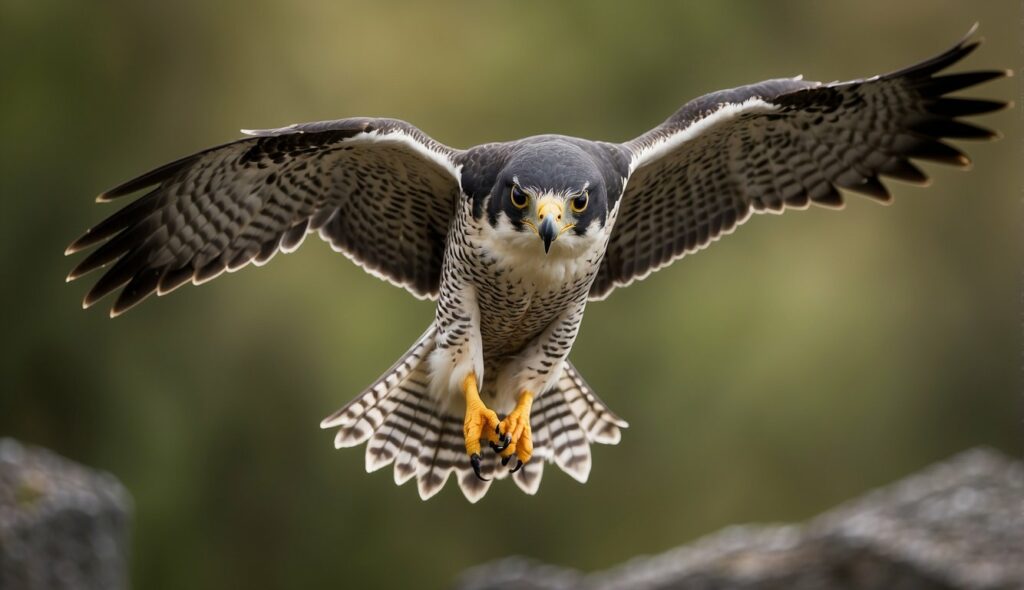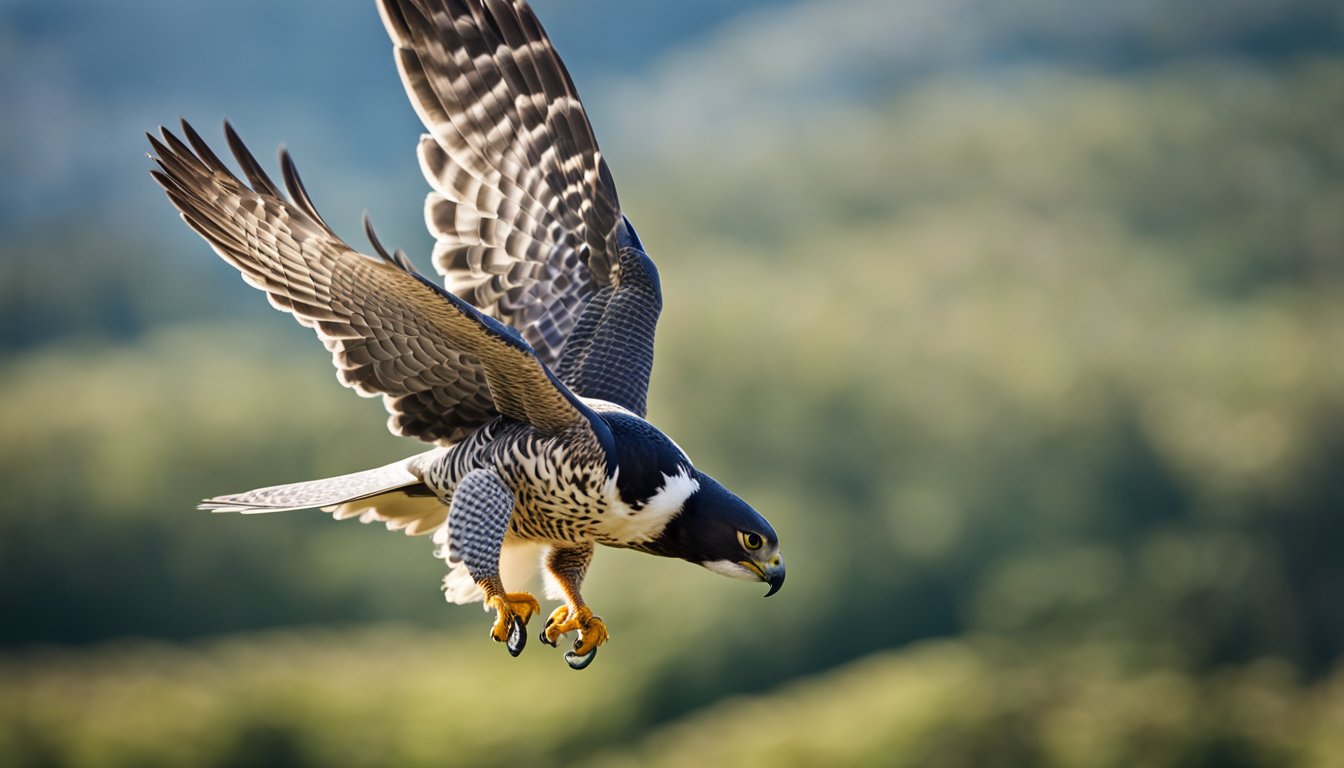Have you ever watched a superhero movie and wished you could zoom through the skies at incredible speeds?
Guess what—there’s a real-life feathered hero who does just that! Meet the peregrine falcon, the fastest bird on the planet.
These amazing flyers reach speeds that no other bird can match, and they do so with style and precision that’s simply awe-inspiring.

When we watch a peregrine falcon in flight, we’re witnessing a master of the air. These birds make the sky look like their own personal playground.
Diving from great heights, they can strike their prey at speeds that can reach up to 200 miles per hour—faster than many cars on the freeway!
It’s hard to believe that something so graceful can also be so powerful.
But it’s not just their speed that makes peregrine falcons special.
They have a unique look too, with beautiful slate-blue wings, a dark head with a distinctive ‘mustache,’ and a sharp beak.
Plus, they’re quite the globetrotters and are found on almost every continent.
Can you imagine having wings that could take you almost anywhere in the world? What an adventure that would be!
Physical Characteristics

Before we dive in, let’s imagine the peregrine falcon like a superhero of the sky.
With its sleek body and incredible flying abilities, this bird is truly a wonder to behold!
Majestic Appearance
Imagine spotting a peregrine falcon up close. You’d see its beautiful blue-grey back glittering in the sunlight.
Looking at its underside, you’d notice barred white feathers that look like they’ve been carefully painted on.
Our feathered friend’s head stands out with a bold black pattern that resembles a mustache—a real trendsetter in the bird world!
Extraordinary Wingspan
When this bird spreads its long pointed wings, it’s ready for action.
The peregrine falcon’s wingspan is mighty impressive—it stretches about 80 to 105 centimeters.
That’s as long as a kitchen countertop!
With a black tip on each point of its wings, it slices through the air like a pair of scissors.
Size Differences
Now, if we were to line up a male and female peregrine falcon side by side, you’d quickly see that the female is bigger, which is quite common in the world of raptors.
In terms of numbers, they can measure from 35 to 50 centimeters in length, and don’t forget about their sharp claws and tail, key tools for steering and balancing at top speeds!
Habitat and Distribution

Peregrine falcons have an incredible knack for making themselves at home in a wide variety of places.
Whether it’s the rocky cliffs along the coast or the towering skyscrapers in the city, they find the perfect spots to live and thrive.
From Coast to Cities
Our feathery friends, the peregrine falcons, are quite the globetrotters.
They are found on every continent except Antarctica, making their homes on natural cliff faces, especially along coastlines where the view is just perfect for spotting a tasty meal.
These cliffs often feature a rock ledge or two for them to rest and nest on.
But it’s not just the wilderness they love; some have even made busy cities across North America and beyond their home too!
Adapting to Urban Environments
Now, you might wonder, how do they manage in the city? Imagine this: a peregrine falcon zooming between skyscrapers as if they were just tall cliffs.
These birds can adapt.
They’ve swapped the natural rock ledges for bridges and the high perches of skyscrapers.
It’s like living in a giant outdoor apartment complex with plenty of room and food. Isn’t that something?
Global Presence
No matter where we travel, from the sunny coast to the chilly tip of a city’s towering structure, there’s a chance to spot a peregrine falcon.
These birds don’t just like to stick to one place; they have quite the international passport, calling every continent home.
How many birds do you know that live just as comfortably on a city balcony as they do on a seaside cliff? Peregrines are worldly creatures indeed!
Remember, when you’re out and about, whether you’re walking by the beach or looking up in the city, keep an eye out for peregrine falcons, nature’s unmatched aviators, enjoying the view from their high-rise homes.
Diet and Hunting

Before we soar into the details, let’s remember that the peregrine falcon is not only the fastest animal on the planet but also a clever hunter.
Its diet includes a variety of birds and sometimes small mammals. Now, let’s dive into what the peregrine falcon eats and how it catches its food!
The Peregrine’s Prey
Peregrine falcons have a diverse menu and they like to change it up depending on where they are and what season it is.
They mainly feast on other birds, such as pigeons, shorebirds, songbirds, and even other birds of prey!
Sometimes, they might snatch a bat out of the sky or a small mammal for a snack.
They also enjoy ducks and gulls when they’re near water.
Imagine having wings and being able to pick your favorite food from the sky buffet!
Incredible Hunting Techniques
Did you know that a peregrine falcon in a hunting dive, or stoop, can whoosh through the air at speeds over 200 mph?
That’s faster than the top speed of a race car!
They use their incredible speed to surprise their prey and capture it with their sharp talons.
One of their super cool methods is to dive super-fast from high up and then, bam!
They strike with precision before the prey even knows what’s happening.
Feeding the Young
Once the hunting job is done, it’s mealtime at the nest, especially for the baby falcons, called eyasses.
Both falcon parents help in feeding their young with bits of the caught prey.
These little ones have huge appetites and can eat an entire bird in just a couple of days!
Feeding the youngsters is a busy task, but it’s important because that’s how they grow up strong and learn to hunt on their own someday.
Reproduction and Lifecycle
Peregrine falcons engage in a fascinating process of reproduction and growth.
We’ll see how they choose partners, create their homes, and nurture their young.
Choosing a Mate
When it comes to finding a mate, peregrine falcons are rather picky, and for good reason!
They often mate for life, relying on a strong bond to raise their offspring successfully.
During the breeding season, males perform daring aerial displays to impress females.
These acrobatics aren’t just for show; they demonstrate the male’s strength and agility, which are crucial for survival in the wild.
Nest Building and Egg Laying
Once mated, peregrine falcons set out to build their home, often high on a cliff face or sometimes on tall structures in urban environments.
They prefer scrapes, shallow depressions in the ground or on ledges, where the female lays her clutch of eggs—usually between two and four.
The nesting site provides safety from predators and a vast view for spotting potential threats.
Raising the Chicks
After the eggs are laid, both the female and male take turns during the incubation period, which lasts around 33 days.
Once hatched, the chicks, called eyasses, depend entirely on their parents for warmth and food.
Peregrine falcon parents are dedicated, bringing a supply of food to ensure their young grow strong and healthy.
The fledglings leave the nest after about six weeks but continue to rely on their parents while they perfect their hunting skills.
Conservation efforts have played a key role in ensuring these magnificent birds continue to grace our skies for years to come.
Through understanding the life cycle of peregrine falcons, we gain insights into the delicacy and resilience of ecosystems and the importance of protecting these incredible creatures.
Frequently Asked Questions
Let’s soar into the world of Peregrine Falcons and discover the amazing secrets of the fastest bird in the sky.
We’ll learn about their incredible speeds, where they live, and some super cool facts that make them extraordinary!
How does the Peregrine Falcon become the speediest bird in the sky?
The Peregrine Falcon achieves breathtaking speeds by diving in a specialized hunting maneuver called a stoop.
During this dive, they tuck their wings close to their body to become more aerodynamic, allowing them to reach speeds possibly reaching 200 miles per hour.
Can you list 10 super cool things about Peregrine Falcons?
Sure! Here are ten awesome facts:
- Peregrine Falcons have a body length of 34 to 58 cm and a wingspan from 74 to 120 cm.
- They can live up to 17 years.
- Peregrines are found on every continent except Antarctica.
- They can reach diving speeds of up to 300 km/h.
- Falcons have excellent eyesight to spot prey from a distance.
- They’re expert fliers and can maneuver with precision.
- The species has made a remarkable comeback from the brink of extinction.
- They can take down birds mid-flight due to their speed.
- Some Peregrine Falcons live in urban areas, nesting on tall buildings.
- They play an important role in their ecosystems as top predators.
Why are Peregrine Falcons found in so many different places, like New York and New Jersey?
Peregrine Falcons are incredibly adaptable, allowing them to thrive in diverse environments.
Their adaptability has made it possible for them to live in various places ranging from coastlines to urban cities like New York and New Jersey.
What incredible speeds can Peregrine Falcons reach and how do they compare with other fast flyers?
Peregrine Falcons are renowned for their extraordinary speed, reaching up to 300 km/h during their hunting stoop, making them faster than any other bird and even surpassing the speed of the fastest cars!
In what ways are Peregrine Falcons fascinating to kids?
For kids, Peregrine Falcons are like superheroes of the sky.
They’re awe-inspiring because of their high-speed chases, their ability to spot a tiny bird from miles away, and their cool-looking feathers.
Learning about them can feel like uncovering the secrets of a real-life action hero.
What are some ways to see Peregrine Falcons in action, through videos or pictures?
There are lots of ways to see these magnificent birds!
You can watch nature documentaries, look up videos of them hunting, or even spot them through webcams installed near their nesting sites.
Photos and videos can give us an up-close view of their thrilling lives.









